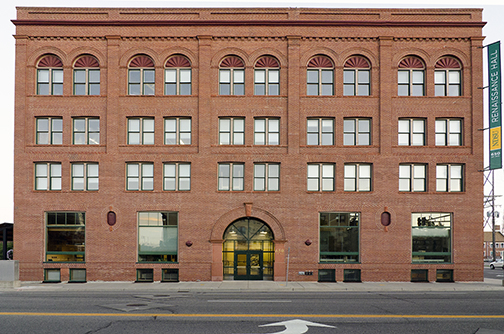
Environmental Design
This is an archived copy of the 2020-21 catalog. To access the most recent version of the catalog, please visit http://bulletin.ndsu.edu.
Environmental Design is broad-spectrum profession that incorporates many disciplines. The bachelor of science in environmental design is preparation for the Master of Landscape Architecture graduate program. Students begin by completing the Bachelor of Science degree with a major in environmental design. Successful performance in the coursework leads to placement in the Master of Landscape Architecture program. A successful student may complete the undergraduate degree in years 1-4 and and begin the first professional Master of Landscape Architecture degree in year 5.
Environmental Design for today and tomorrow, is a primer for architecture and landscape architecture and planning is covered in the following topics: introduction to environmental design, relationship to the environment: climate, land, water, communication with design, spatial relationships, color theories in design, form and geometries, materials and sustainability, natural materials/sustainable materials, design process’, space articulation, historical relationships, social aspects of design, style and individuality, and client’s concerns. How does conservation, remediation and sustainability play a role? Does technology change our thinking? How do we accommodate the world’s growing population; carrying capacity beyond limits? Questions as these are explored in our educational process.
Career Opportunities
The majority of environmental designers continue on with their education to become landscape architects. Many work for landscape architecture services and firms, engineering, architecture and planning companies. Within all these job possibilities exists the opportunity to apply the ethical imperatives of conservation, remediation and sustainability to increasing challenges of energy requirements.
High School Preparation
We suggest that students take high school courses in digital drawing and animation, art, perhaps drawing from life, math and science courses such as calculus, trigonometry, physics and biology. And, if possible, we encourage high school students to take advanced placement or college credit courses that fulfill NDSU General Education requirements.
Please note this is a sample plan of study and not an official curriculum. Actual student schedules for each semester will vary depending on start year, education goals, applicable transfer credit, and course availability. Students are encouraged to work with their academic advisor on a regular basis to review degree progress and customize an individual plan of study.
| First Year | |||
|---|---|---|---|
| Fall | Credits | Spring | Credits |
| ENVD 101 | 3 | ENVD 104 | 1 |
| ENVD 102 | 1 | ENVD 172 | 3 |
| ENVD 130 | 3 | ENGL 120 | 3 |
| ARCH 321 | 3 | COMM 110 | 3 |
| ENGL 110 | 4 | ANTH 111 | 3 |
| PSYC 111 or SOC 110 | 3 | Gen Ed Quantitative Reasoning | 3 |
| Gen Ed Wellness | 2 | ||
| 17 | 18 | ||
| Second Year | |||
| Fall | Credits | Spring | Credits |
| LA 231 | 3 | LA 232 | 3 |
| LA 271 | 6 | LA 272 | 6 |
| LA 321 | 4 | Gen Ed Science & Tech | 3 |
| PLSC 355 | 3 | Gen Ed Science & Tech | 3 |
| Elective or Minor Requirement | 3 | ||
| 16 | 18 | ||
| Third Year | |||
| Fall | Credits | Spring | Credits |
| LA 331 | 3 | LA 342 | 4 |
| LA 341 | 4 | ENGL 326 or 357 | 3 |
| LA 371 | 6 | Elective or Minor Requirement | 3 |
| Gen Ed Science & Tech with Lab | 4 | LA 372 | 6 |
| 17 | 16 | ||
| Fourth Year | |||
| Fall | Credits | Spring | Credits |
| LA 471 | 6 | LA 472 or ARCH 474 | 6 |
| Elective or Minor Requirement | 3 | LA 441 | 4 |
| Elective or Minor Requirement | 3 | LA 422 | 3 |
| Elective or Minor Requirement | 3 | ||
| 15 | 13 | ||
| Total Credits: 130 | |||
